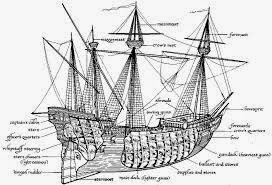Striped Socks
Yes, pirates wore stripey socks! 300 years ago, there were a lot of laws about what kind of clothes working-class people could wear. The type of fabric, the color, even the amount that went into a single garment was controlled by “sumptuary laws.” The rich didn’t want anyone to “get above their station” by dressing too nicely!
One of the few things that was not controlled was
socks. So when a pirate first came into some money, he often went out and
bought the most expensive pair of socks he could find – knee-high, brightly
colored, and often striped.
To the people of the time, it gave the same
impression as the uber-expensive hoodies worn by today’s gangsters.
How big was a pirate ship?
Everyone imagines pirate ships as being huge,
square-masted, and carrying hundreds of guns. Movies like the Pirates of the
Caribbean franchise just enhance this image. In fact, most pirate ships were
small, nimble sloops and schooners with triangular sails.
While pirates robbed anyone they could catch, the
proper proportions between a pirate ship and a merchant vessel was the same as
between a wolf and a cow. And the pirates were just as likely to form a group
in order to attack lager prey.
The merchants handed over their goods to the
pirates for the same reason people give their money to a nervous teenager with
a knife. Anything can happen, and suddenly it becomes apparent that there are
things much more important than money.
Pirates and private property
One of the perks of being a pirate was a chance to
own some basic household goods. Unlike regular sailors, pirates owned several
changes of clothes, plates, and even silverware. The remains of sunken pirate
ships have turned up pewter dishes with the names of their owners proudly – if crudely
- engraved on them.
Often sailors on merchant ships were forced to eat
out of common buckets, using their hands.
Silk ribbons
Pirates improved the smooth wooden grips on their
pistols by wrapping them in silk ribbon. And in order to carry more than two at
a time, they tied pairs of pistols together with longer ribbons, then draped
them over their shoulders.
No one ever said it looked too feminine. Wonder
why?
Blackbeard
Although he cultivated a fearsome reputation, the
pirate Blackbeard never harmed any of his captives… In fact, the only deaths or
injuries proven to be caused by Blackbeard were during his final battle, when
he was attacked by the British Navy.
Not so privileged
Not only were pirate captains elected by their crews,
but they lacked most of the perks assumed by navy and merchant captains. In
fact, a pirate captain could not usually even count on privacy in his own
cabin. Most ships had rules stating that anyone had the right to barge into the
captain’s cabin whenever they wanted.
Tortuga
The name of the famous pirate haunt is simply the
Spanish word for “Turtle.” There are several islands by this name in the
Caribbean. Some were named because their shape looked like the dome of a turtle’s
shell, others because sea turtles laid eggs there.
Davy Jones
The name “Davy Jones” does not refer to a person,
either real or fictional. It is simply a seaman’s slang for the devil. Going to
“Davy Jones’ Locker” meant that when you died, you weren’t going to heaven.
Walking the plank
Pirates may have thrown some of their prisoners overboard,
but they never imagined making them walk the plank. It’s an entirely fictional
idea dreamed up by a penny-novelist trying to sell adventure books. But, after
pirates had read some of the stories, they began to practice the ritual. They’d
read it in a book; it must be true.
Saucy Sadie
A female river-pirate named Sadie the Goat (for
her habit of head-butting her opponents in a fight) got into a scuffle with an
equally tough lady, a six-foot-tall bouncer named Gallius Mag. Mag won the
fight by biting Sadie’s ear off, and kept the ear as a souvenir.
Years later, the women met again and became
friends. Mag gave Sadie the ear back, and Sadie wore it on a chain around her
neck for the rest of her life.



































